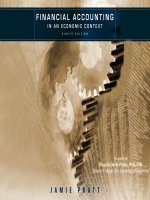45 test bank for financial accounting in an economic context 9th edition
Bạn đang xem bản rút gọn của tài liệu. Xem và tải ngay bản đầy đủ của tài liệu tại đây (60.58 KB, 14 trang )
45 Test Bank for Financial Accounting in an Economic
Context 9th Edition
Pratt
Multiple Choice Questions
Intangible assets are:
1.
a. goodwill, patents, copyrights, and trademarks.
2.
b. property, plant, and equipment.
3.
c. all assets except current assets.
4.
d. those assets that an owner can purchase with cash only.
Desert Company has retained earnings of $11,000, total assets
totaling $41,000, and total liabilities of $20,000. How much is total
shareholders’ equity?
1.
a. $8,000
2.
b. $19,000
3.
c. $21,000
4.
d. $27,000
Valley Company has cash, current liabilities, and long-term
liabilities of $120,000, $30,000, and $31,000, respectively. Valley
has no current assets other than cash. How much cash can
Valley use to acquire equipment so that amount of current assets
is double the amount of current liabilities?
1.
a. $30,000
2.
b. $60,000
3.
c. $15,000
4.
d. $90,000
Below are several accounts from Norel Company’s accounting
records: Total assets, end of year $110,000; Total liabilities, end
of year 36,000; Contributed capital, end of year 12,000; Retained
earnings, beginning of year 18,000; Dividends for the period
31,000; Net income 75,000. The amount of retained earnings at
the end of the year is:
1.
a. $34,000.
2.
b. $40,000.
3.
c. $62,000.
4.
d. $64,000.
If the beginning and ending balances in retained earnings are
$15,000 and $10,000, respectively, and dividends during the year
are $8,000, then net income for the year is:
1.
a. $10,000.
2.
b. $3,000.
3.
c. $18,000.
4.
d. $32,000.
Current assets are:
1.
a. all assets except inventory.
2.
b. all assets that provide benefits extending beyond one year.
3.
c. cash, accounts receivable, and buildings.
4.
d. all assets that are expected to be converted to cash in the near future.
The amount a company expects to collect from its customers is:
1.
a. accounts receivable.
2.
b. short-term equity securities.
3.
c. inventory.
4.
d. accounts payable.
Which one of the following appears on the income statement?
1.
a. Inventory.
2.
b. Retained earnings.
3.
c. Dividends.
4.
d. Interest revenue.
Which one of the following groups of accounts contains only
current assets?
1.
a. Inventory, accounts receivable, equipment.
2.
b. Cash, equipment, copyrights.
3.
c. Cash, accounts receivable, merchandise inventory.
4.
d. Patents, copyrights, and trademarks.
The acquisition of equity and debt financing is considered:
1.
a. a financing activity.
2.
b. net income.
3.
c. an investing activity.
4.
d. an operating activity.
Favre Company has current assets, shareholders’ equity, current
liabilities, and long-term liabilities of $10,000, $27,000, $4,000,
and $8,000, respectively. How much are long-term assets?
1.
a. $12,000
2.
b. $29,000
3.
c. $32,000
4.
d. $46,000
Your bank loaned ten million dollars to Hamilton Stores to finance
the construction of a manufacturing plant. In which section of
Hamilton’s statement of cash flows would you be able to
determine whether the company used the cash to build the new
plant?
1.
a. Operating activities
2.
b. Owner activities
3.
c. Financing activities
4.
d. Investing activities
On which financial statements will you find a company’s financial
position at a specific point in time?
1.
a. All financial statements combined.
2.
b. Income statement and balance sheet.
3.
c. Balance sheet and statement of shareholders’ equity.
4.
d. Balance sheet only.
Which account is associated with borrowing money?
1.
a. Interest expense.
2.
b. Goodwill.
3.
c. Cost of goods sold.
4.
d. Depreciation.
A partnership and a corporation differ in that:
1.
a. a partnership is a legal entity, while a corporation is not.
2.
b. the equity sections of partnership and corporation balance sheets report
different items.
3.
c. partnerships always have more cash than corporations.
4.
d. a corporation has an income statement and a partnership does not.
Which one of the following groups of accounts contains only
assets?
1.
a. Contributed capital, retained earnings, revenues.
2.
b. Cash, contributed capital, retained earnings.
3.
c. Prepaid expenses, land, accounts receivable.
4.
d. Building, equipment, depreciation expense.
Cash reported on a company’s balance sheet represents
1.
a. the profit a company made during the current year.
2.
b. the amount the President of the Company has in his or her personal
account.
3.
c. the amount collected from customers during the current year less the
amount paid for expenses.
4.
d. the currency a company has access to at the balance sheet date.
Seuss Company determined its total sales were $500,000,
salaries expense was $210,000, dividends paid were $15,000,
rent expense was $25,000, other operating expenses were
$13,000, and customers still owed $4,000 at the end of the year.
How much is net income for the year?
1.
a. $267,000.
2.
b. $252,000.
3.
c. $263,000.
4.
d. $530,000.
The major accounting difference between interest expenses for
creditors and dividends declared and paid to shareholders is that
interest expenses:
1.
a. decrease retained earnings and dividends increase retained earnings.
2.
b. impact cash flows, while dividends do not.
3.
c. are not on the income statement while dividends declared and paid are.
4.
d. are on the income statement and dividends declared and paid are not.
Smith Corp. earned $300,000 profit during 2015. On which
financial statement(s) will the exact dollar amount of the profit be
clearly stated?
1.
a. Statement of shareholders’ equity and income statement.
2.
b. Income statement only.
3.
c. Balance sheet and income statement.
4.
d. Statement of shareholders’ equity, income statement, and the balance
sheet.
Which one of the following is a liability?
1.
a. Interest receivable.
2.
b. Contributed capital.
3.
c. Retained earnings.
4.
d. Wages payable.
Which one of the following creates a decrease in retained
earnings?
1.
a. Prepaid assets.
2.
b. Equipment.
3.
c. Dividends.
4.
d. Merchandise inventory not sold.
Most investors believe that the statement of cash flows is
1.
a. a useful source of information regarding the cash flow of an entity.
2.
b. the only statement in an annual report whose results correlates to stock
price value.
3.
c. too complicated.
4.
d. a useful measure of a company’s profit.
Property, plant and equipment may include which of the
following?
1.
a. Intangible assets and land.
2.
b. Inventory and equipment.
3.
c. Buildings and cash.
4.
d. Land and office buildings.
Which one of the following groups of accounts contains only
liabilities?
1.
a. Accounts payable, retained earnings, notes payable.
2.
b. Supplies expense, cost of goods sold, interest expense.
3.
c. Wages payable, mortgage payable, taxes payable.
4.
d. Contributed capital, accounts payable, retained earnings.
The most common revenue account is:
1.
a. cash.
2.
b. sales.
3.
c. shareholders’ equity.
4.
d. liabilities.
Which account is associated with the sale of inventory?
1.
a. Cost of goods sold.
2.
b. Depreciation.
3.
c. Inventory expense.
4.
d. Equipment.
On the balance sheet, a company should report the cost of
intangible assets:
1.
a. in the current assets section.
2.
b. as an amount owed to shareholders.
3.
c. as an amount that is estimated by the CFO.
4.
d. at acquired cost less any accumulated amortization.
As used in accounting, “notes” may be reported:
1.
a. only as company debt offerings.
2.
b. only as assets on the balance sheet.
3.
c. as either assets or liabilities.
4.
d. on the income statement or the balance sheet.
Which expense is associated with the use of patents?
1.
a. Interest.
2.
b. Amortization.
3.
c. Cost of goods sold.
4.
d. Depreciation.
The amount reported on a company’s balance sheet as retained
earnings is the same as the amount reported on the company’s:
1.
a. income statement as net income.
2.
b. statement of shareholders’ equity as beginning retained earnings.
3.
c. statement of cash flows as cash received from operating activities.
4.
d. statement of shareholders’ equity as ending retained earnings.
Why are liabilities separated into current and long-term?
1.
a. Users want to know which amounts will be paid using current assets.
2.
b. Because current and long-term classifications are just common sense.
3.
c. This format helps a company determine how much profit was made.
4.
d. The SEC requires companies to do so.
Which one of the following equations represents retained
earnings activity for a year?
1.
a. Beginning balance + expenses – dividends = ending balance.
2.
b. Beginning balance + cash receipts – cash payments = ending balance.
3.
c. Beginning balance + dividends – net income = ending balance.
4.
d. Beginning balance + net income – dividends = ending balance.
Which one of the following groups of accounts contains only
assets?
1.
a. Equipment, patents, accounts receivable.
2.
b. Accounts receivable, building, retained earnings.
3.
c. Accounts payable, notes payable, contributed capital.
4.
d. Retained earnings, goodwill, and accounts payable.
At the end of 2014, Campbell Company has total assets and
liabilities at $42,000 and $11,000, respectively. Campbell
reported net income for 2015 in the amount of $12,000. How
much is shareholders’ equity at the end of 2015?
1.
a. $30,000
2.
b. $22,000
3.
c. $31,000
4.
d. $43,000
Long-term investments can include all of the following except:
1.
a. notes receivable maturing in nine months.
2.
b. equity securities of another company to be held for more than a year.
3.
c. ten-year debt securities of another company.
4.
d. land to be held beyond one year.
Which one of the following is an asset?
1.
a. A patent of a company’s secret formula for reverse osmosis.
2.
b. Retained earnings.
3.
c. Notes payable.
4.
d. Accounts payable.
Kelly Company has total assets, liabilities, and shareholders’
equity of $32,000, $17,000, and $15,000, respectively at the
beginning of 2015. If Kelly reports revenues of $130,000,
expenses of $80,000, and pays dividends of $30,000, how much
is shareholders’ equity at the end of 2015?
1.
a. $35,000
2.
b. $53,000
3.
c. $44,000
4.
d. Not enough information to determine.
Given below are several accounts from Caterpillar Company’s
accounting records: Cash $ 15,000; Accumulated depreciation
7,000; Retained earnings, beginning of year 22,000; Contributed
capital 25,000; Patents 2,000; Dividends 5,000. Net income for
the year was $40,000. How much is total shareholders’ equity at
the end of the year?
1.
a. $86,000.
2.
b. $88,000.
3.
c. $87,000.
4.
d. $82,000.
Which one of the following statements is true?
1.
a. A company’s own stock is its most liquid asset.
2.
b. Profits are normally kept in a company’s retained earnings until
distributed as dividends.
3.
c. Long-term investments will be used to pay current liabilities.
4.
d. Current assets have no physical substance.
When an entrepreneur wishes to start a business, capital must be
attracted in the form of:
1.
a. net income.
2.
b. cost of goods sold.
3.
c. operating activities.
4.
d. equity or debt financing.
Which expense is associated with long-term assets?
1.
a. Dividends.
2.
b. Depreciation.
3.
c. Cost of goods sold.
4.
d. Interest.
Sanchez Corporation has total assets, current liabilities, and longterm liabilities of $40,000, $2,000, and $13,000, respectively. If
Sanchez purchases equipment for $5,000 for cash, how much
would shareholders’ equity be?
1.
a. $25,000
2.
b. $10,000
3.
c. $29,000
4.
d. $11,000
Which one of the following is not an asset?
1.
a. A company’s equity in the common stock of another company.
2.
b. A company’s trademarked name for a process.
3.
c. Retained earnings.
4.
d. Notes receivable.
Which one of the following is considered an operating activity?
1.
a. Payment to a vendor for supplies.
2.
b. Purchase of company trucks for cash.
3.
c. Payment of dividends to shareholders.
4.
d. Issuing stock to investors.









